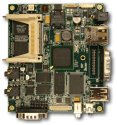Intrinsyc’s CerfBoard catches the Bulverde wave
Dec 1, 2005 — by LinuxDevices Staff — from the LinuxDevices Archive — 11 views Intrinsyc is shipping a higher-powered, lead-free, larger version of its venerable “CerfBoard” Linux development kit. The CerfBoard 270 is based on an Intel XScale PXA27x (Bulverde) processor, and meets the EU's RoHS (reduction of hazardous substances) act requirements, the company says. It comes preloaded with Linux 2.6, and is meant to be a starting point for embedded Linux developers creating wireless computing, telematics, industrial automation, and remote monitoring devices.
Intrinsyc is shipping a higher-powered, lead-free, larger version of its venerable “CerfBoard” Linux development kit. The CerfBoard 270 is based on an Intel XScale PXA27x (Bulverde) processor, and meets the EU's RoHS (reduction of hazardous substances) act requirements, the company says. It comes preloaded with Linux 2.6, and is meant to be a starting point for embedded Linux developers creating wireless computing, telematics, industrial automation, and remote monitoring devices.
(Click for larger view of CerfBoard 270)
The CerfBoard, and CerfCube
Intrinsyc launched its CerfBoard Linux development kit in May of 2000. The original CerfBoard was powered by a StrongARM SA-1110 processor clocked at 206MHz, and was optionally available as the “CerfCube,” with a 0.015 cubic foot cast aluminum case.
The original CerfBoard, inside the CerfCube case (shown upside down)
Both “Cerf” products featured onboard Ethernet interfaces, and may have been named in homage to Vint Cerf, an early contributor to TCP/IP and other Internet protocols. The Cerf products were supported by a MontaVista Linux “preview kit” as early as 2002.
In July, 2003, Intrinsyc followed up with a version of the CerfBoard/Cube based on a PowerPC 405EP.
The CerfBoard 270
The new CerfBoard 270 is quite a bit larger than the original, measuring 4.5 x 4.2 inches (114 x 104 mm) with connectors, or 4.2 x 3.75 inches (108 x 95mm) without. It is also considerably more powerful, since it is based on Intel's XScale PXA270 (Bulverde) mobile multimedia processor, clocked at 416MHz (with clock speeds of 524MHz optionally available).
Features of the board include:
- 32MB of Intel StrataFlash
- 64MB of DRAM with low-power sleep mode (128MB optionally available)
- LCD connector for Sharp and Optrex displays (Linux driver pending)
- LCD backlight connector
- Touch-panel connector
- Dual Type II CompactFlash slots
- SD/MMC slot
- 2 x USB 2.0 host ports
- 1 x USB 1.1 host port
- 1 x USB 1.1 device port
- 2 x serial ports with DB9 connectors
- COM1 — full serial RS-232 support
- COM2 — 3-wire RS-232 for debug
- Digital I/O on 2x10x100 connector
- Expansion connector for 16 bit data bus, address bus, camera interface,
4-wire UART, I2C - Stereo out, mic in connectors
- Battery-backed RTC (real-time clock)
- EEPROM and FRAM on I2C
- CPU and CPLD JTAG connectors
- Supports 4-12VDC input voltages
- All peripherals have built-in power controls (Linux driver pending)
The CerfBoard 270 is supplied preloaded with a Linux 2.6 kernel. Linux kernel and file-system images can be downloaded through Ethernet and written into flash by the bootloader. The bootloader, in turn, can be programmed into Flash through the JTAG connectors, Intrinsyc says. A cross-compilation Linux toolchain is also provided.
Other PXA270 development boards and services have been launched this year by CompuLabs, Micro/sys, Anders Electronics, InHand, QuickLogic, ADS, Toradex, and First Technology, among others.
Availability
The CerfBoard 270 is available now, with Linux BSP (some drivers pending) and tools.
Intrinsyc has not stated whether it plans to offer a CerfCube case for the new, larger CerfBoard.
This article was originally published on LinuxDevices.com and has been donated to the open source community by QuinStreet Inc. Please visit LinuxToday.com for up-to-date news and articles about Linux and open source.
